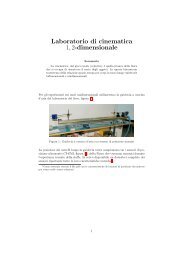Newton's law of cooling revisited - Cartan
Newton's law of cooling revisited - Cartan
Newton's law of cooling revisited - Cartan
Create successful ePaper yourself
Turn your PDF publications into a flip-book with our unique Google optimized e-Paper software.
1072 M Vollmer<br />
Figure 4. Theoretical <strong>cooling</strong> <strong>of</strong> Al metal cubes with size 40 mm and ε = 0.9 for different<br />
convective heat transfer coefficients. Newton’s <strong>law</strong> would be a straight line such as the broken<br />
lines, which closely describe the low temperature data, but show deviations for larger temperatures.<br />
(a) (b)<br />
Figure 5. Extreme cases <strong>of</strong> <strong>cooling</strong> <strong>of</strong> Al metal cubes (s = 4 cm): small convection with large<br />
radiation heat transfer (a) and large convection with small radiative heat transfer (b).<br />
with high air speed onto the objects. In this case, very high values <strong>of</strong> up to 100 W m −2 K seem<br />
possible. As a result, no deviation from the straightline plot is observable, i.e. Newton’s <strong>law</strong><br />
would hold for the whole temperature range <strong>of</strong> �T = 500 K.<br />
In order to further understand the relevance <strong>of</strong> the nonlinearities during the <strong>cooling</strong> <strong>of</strong><br />
objects, we now consider the relative contributions <strong>of</strong> radiation and convection heat transfer.




